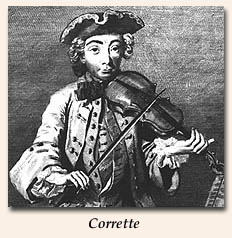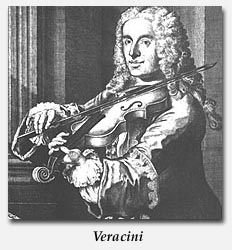
 I think what Zukerman and Perlman are really talking about is not so much performance practice but taste. They learned a very different style and they love it. They know little about historical performance, can’t understand what it has to offer musically, and resent its popular success. They can’t bear the thought that all those people buying historically informed performances on CD understand more than they do about the way the music sounds best. In short, they seem to be afraid.
I think what Zukerman and Perlman are really talking about is not so much performance practice but taste. They learned a very different style and they love it. They know little about historical performance, can’t understand what it has to offer musically, and resent its popular success. They can’t bear the thought that all those people buying historically informed performances on CD understand more than they do about the way the music sounds best. In short, they seem to be afraid.
 This fear (or is it the gradual diffusion of a change in taste?) is becoming the catalyst for a few outstanding mainstream performers to inform themselves about historical style. A few years ago, when I was out of town, I received an urgent message to call collect a principal player of The Cleveland Orchestra. The Orchestra was playing Bach, which it hadn’t done for a long time, and this person was uncomfortable playing it the usual way. The specific questions I had to answer about articulation and ornamentation amounted to a mini-lesson in baroque performance practice and marked, in my own experience, a turning point in the receptivity of the mainstream to performance practice ideas. We still have a long way to go, however.
This fear (or is it the gradual diffusion of a change in taste?) is becoming the catalyst for a few outstanding mainstream performers to inform themselves about historical style. A few years ago, when I was out of town, I received an urgent message to call collect a principal player of The Cleveland Orchestra. The Orchestra was playing Bach, which it hadn’t done for a long time, and this person was uncomfortable playing it the usual way. The specific questions I had to answer about articulation and ornamentation amounted to a mini-lesson in baroque performance practice and marked, in my own experience, a turning point in the receptivity of the mainstream to performance practice ideas. We still have a long way to go, however.

 Historically informed performances require the performer to think much more than mainstream performances do, to make real-time decisions that have not, in recent decades, been left up to the performer. This is because mainstream performance training has been based on the “do it the teacher’s way” approach…through imitation without a lot of discussion. There are various performance styles within this tradition, but still, there is a kind of “received style” that allows for this apprenticeship kind of training. Historical performance, on the other hand, is based on the notion that a number of the parameters of performance are left up to the performers in real time, that there are choices to be made within certain stylistic probabilities, and that this imbues the music with a sense of freshness and spontaneity it otherwise might lack, and provides the performers with a sense of control and liberty which they are generally not allowed in the received tradition.
Historically informed performances require the performer to think much more than mainstream performances do, to make real-time decisions that have not, in recent decades, been left up to the performer. This is because mainstream performance training has been based on the “do it the teacher’s way” approach…through imitation without a lot of discussion. There are various performance styles within this tradition, but still, there is a kind of “received style” that allows for this apprenticeship kind of training. Historical performance, on the other hand, is based on the notion that a number of the parameters of performance are left up to the performers in real time, that there are choices to be made within certain stylistic probabilities, and that this imbues the music with a sense of freshness and spontaneity it otherwise might lack, and provides the performers with a sense of control and liberty which they are generally not allowed in the received tradition.
 This raises the very serious question: can, in fact, historical performance be taught as a received tradition? I know one person who maintains adamantly that it cannot, that the kind of analytical, thoughtful, responsible approach necessary for historically informed performance cannot be taught by emulation, that there is too much to be known about the music and the background and the performance practice, and every performer has to know it, not just the teacher or the conductor. This is an extreme position, but it may help to explain why so many early music programs in colleges and conservatories continue to be directed by music historians. “Real” performers don’t have time to learn all that other stuff! I would like to suggest that historically informed performance is a valuable way of thinking about music — virtually all music — whether it comes from earlier centuries or not. It doesn’t hurt to re-examine evolved manners of playing any music for which the composer is no longer around to ask his or her preferences.
This raises the very serious question: can, in fact, historical performance be taught as a received tradition? I know one person who maintains adamantly that it cannot, that the kind of analytical, thoughtful, responsible approach necessary for historically informed performance cannot be taught by emulation, that there is too much to be known about the music and the background and the performance practice, and every performer has to know it, not just the teacher or the conductor. This is an extreme position, but it may help to explain why so many early music programs in colleges and conservatories continue to be directed by music historians. “Real” performers don’t have time to learn all that other stuff! I would like to suggest that historically informed performance is a valuable way of thinking about music — virtually all music — whether it comes from earlier centuries or not. It doesn’t hurt to re-examine evolved manners of playing any music for which the composer is no longer around to ask his or her preferences.
 And that, of course, raises the point that even when we know a composer’s preferences about some aspects of performance practice, whether from earlier centuries or more recent times, the composer may not know exactly what is best for the music, and/or may not be the best performer of the music even though we have come to assume that is so. Richard Taruskin perceptively cites the example of Stravinsky, who insisted on the sanctity of the composer’s intentions, and who gave the most precise possible tempo indications in his scores. There are recordings of some of these works that he himself conducted — sometimes four or five different recorded performances of the same work — and not a single one comes close to the tempo he so meticulously called for, and which most other conductors, no doubt, read as scripture. So even when we think we know the composer’s precise intentions, we ultimately have to depend on our own conviction that what we are doing is appropriate for the music and meaningful for the audience. And the differences between two or three Corelli solo performances show that there is room for considerable personal choice even when we have something as precise as those purported Corelli embellishments of Opus V.
And that, of course, raises the point that even when we know a composer’s preferences about some aspects of performance practice, whether from earlier centuries or more recent times, the composer may not know exactly what is best for the music, and/or may not be the best performer of the music even though we have come to assume that is so. Richard Taruskin perceptively cites the example of Stravinsky, who insisted on the sanctity of the composer’s intentions, and who gave the most precise possible tempo indications in his scores. There are recordings of some of these works that he himself conducted — sometimes four or five different recorded performances of the same work — and not a single one comes close to the tempo he so meticulously called for, and which most other conductors, no doubt, read as scripture. So even when we think we know the composer’s precise intentions, we ultimately have to depend on our own conviction that what we are doing is appropriate for the music and meaningful for the audience. And the differences between two or three Corelli solo performances show that there is room for considerable personal choice even when we have something as precise as those purported Corelli embellishments of Opus V.
 This brings me back to my second question: What does performance practice require of you, if you’re a performer of baroque music? (And I mean this whether you play an historical instrument or a modern instrument ) Nobody could possibly be expected to know all of the answers to every performance practice question, even if they confined themselves to a single repertoire. The important thing is to inform your intuition. Absorb what you can of the relevant performance practice knowledge. Internalize it. Develop a sense of style that is based on historical information and make your musical decisions “real-time” from that standpoint. When some specific question arises, you can find an answer or, more likely, a range of possibilities, in the kinds of sources I’ve mentioned. But do it yourself; don’t take someone else’s word for it. Then, based on the new information, make your own decision about how you’re going to put the music across.
This brings me back to my second question: What does performance practice require of you, if you’re a performer of baroque music? (And I mean this whether you play an historical instrument or a modern instrument ) Nobody could possibly be expected to know all of the answers to every performance practice question, even if they confined themselves to a single repertoire. The important thing is to inform your intuition. Absorb what you can of the relevant performance practice knowledge. Internalize it. Develop a sense of style that is based on historical information and make your musical decisions “real-time” from that standpoint. When some specific question arises, you can find an answer or, more likely, a range of possibilities, in the kinds of sources I’ve mentioned. But do it yourself; don’t take someone else’s word for it. Then, based on the new information, make your own decision about how you’re going to put the music across.
 It is at this point that you indeed say, “I know what some of the possibilities are. Now I’m going to do it the way it feels right to me.” It’s that sense of freedom and responsibility which is the essence of historically informed performance. And remember, as far as the listener is concerned, precisely how it sounded then doesn’t matter: what matters is how it sounds now.
It is at this point that you indeed say, “I know what some of the possibilities are. Now I’m going to do it the way it feels right to me.” It’s that sense of freedom and responsibility which is the essence of historically informed performance. And remember, as far as the listener is concerned, precisely how it sounded then doesn’t matter: what matters is how it sounds now.